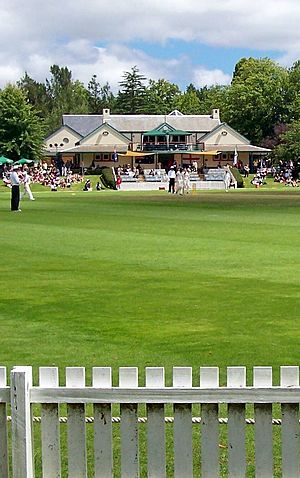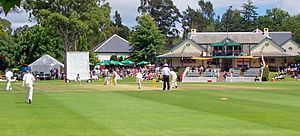Bradman Oval facts for kids
Quick facts for kids Bradman Oval |
|
|---|---|
 |
|
| Location | Glebe Street, Bowral, Wingecarribee Shire, New South Wales, Australia |
| Elevation | 690m |
| Built | 1893 |
| Owner | Wingecarribee Shire Council |
| Official name: Bradman Oval and Collection of Cricket Memorabilia; Glebe Park | |
| Type | state heritage (complex / group) |
| Designated | 23 June 2000 |
| Reference no. | 1399 |
| Type | Cricket Pitch/ Ground |
| Category | Recreation and Entertainment |
| Lua error in Module:Location_map at line 420: attempt to index field 'wikibase' (a nil value). | |
| Ground information | |
| International information | |
| Only women's Test | 15 February 2008: |
| First WODI | 1 February 2000: |
| Last WODI | 18 November 2014: |
| As of 7 September 2020 Source: CricketArchive |
|
Bradman Oval is a famous cricket ground in Bowral, New South Wales, Australia. It's named after the legendary cricketer Don Bradman. He lived nearby and played many games here when he was young. This special place is also known as Glebe Park. It was added to the New South Wales State Heritage Register on 23 June 2000, meaning it's an important historical site.
The ground is very pretty, with a classic white picket fence and an old-fashioned building called a pavilion. Tall Camden Woollybutt gum trees grow around the playing field. Up to 5,000 people can watch games here using extra seating.
Bradman Oval and the nearby International Cricket Hall of Fame are popular places for cricket fans. People from Australia and all over the world visit to learn about cricket history.
Contents
The History of Cricket in Australia
The very first cricket match in Australia was played in Sydney on 8 January 1804. It took place in a park now known as Hyde Park. By the 1830s, different clubs in Sydney started playing against each other. When gold was discovered in the 1850s, cricket quickly became popular in other parts of Australia too.
The land where Bradman Oval sits was once part of Glebe Park. It was given to the Church of England a long time ago.
Don Bradman's Early Life in Bowral
In 1911, George and Emily Bradman moved to Bowral with their family. Their youngest child, Don Bradman, was only three years old at the time. Don lived in this house from age three to fifteen, and it was a very important time for him.
Don started school at Bowral Public School in 1913. His headmaster said he was especially good at maths and French. He also learned to play the piano and later became a talented musician and businessman.
How Don Bradman Became a Cricket Legend
Every afternoon after school, young Don would rush home. He would go straight to the tank stand in his yard. There, he practiced his cricket skills using a golf ball and a cricket stump. This practice helped him develop amazing reflexes. These skills made him the greatest batsman in Australia, with an incredible average of 99.94 runs.
When he was 12, Don scored his first century (100 runs in one game). He also played his first game on this oval at age 12, scoring 29 runs without being out for the Bowral Cricket Club.
In 1925, Bradman joined the Bowral Cricket Club. In his first season, he scored 1,318 runs, averaging 94.14 runs per game. He also took 51 wickets and caught 26 balls. Another famous game on this ground was in 1925. Bradman scored 234 runs against the Wingello team, which included the great bowler Bill O'Reilly.
Bradman Oval's Development
In 1947, the cricket pitch was officially named Bradman Oval. Over the years, many improvements were made to the ground. The Bowral Municipal Council and a local man named Gordon Whatman worked hard to keep the oval in great condition.
In 1976, Sir Donald Bradman himself helped reopen the newly improved Bradman Oval. He was joined by his old rival and friend, the famous Australian bowler Bill O'Reilly.
The Pavilion, a building overlooking the oval, opened in 1989. It has a Player's Club Room, changing rooms, and a meeting room. Next to the Pavilion is the Museum, which opened on Sir Donald's 88th birthday in 1996.
What Bradman Oval Looks Like
Bradman Oval is surrounded by Glebe Street, Boolwey Street, St Jude Street, and Bowral Street. It's part of a large park with many tall eucalyptus trees. These trees might be left over from the original plants that grew here. There are also other types of trees along the edges of the park.
The park also has a children's playground. You can find an old road roller and an adventure playground on the eastern side. The International Cricket Hall of Fame is also located within this park area.
Why Bradman Oval is a Heritage Site
Bradman Oval is very important to the history of New South Wales. It's famous because of its connection to Sir Donald Bradman's amazing cricket career. The Bradman Museum and the name change to Bradman Oval help remember this national cricket history. The oval helps us connect to Don Bradman's early years.
The park was once called Glebe Park. It shows what country town parks looked like around the year 1900. These parks had simple layouts with trees and a few bushes. It also shows how Bowral started to care more about its garden environments. The mix of old eucalyptus trees and other trees makes the park very beautiful.
Bradman Oval was officially added to the New South Wales State Heritage Register on 23 June 2000. This means it's protected and recognized for its historical and cultural value.


